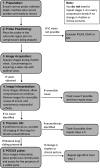The use of critical care echocardiography in peri-arrest and cardiac arrest scenarios: Pros, cons and what the future holds
- PMID: 34422106
- PMCID: PMC8373287
- DOI: 10.1177/1751143720936998
The use of critical care echocardiography in peri-arrest and cardiac arrest scenarios: Pros, cons and what the future holds
Abstract
Echocardiography is being increasingly deployed as a diagnostic and monitoring tool in the critically ill. This rise in popularity has led to its recommendation as a core competence in intensive care, with several training routes available. In the peri-arrest and cardiac arrest population, point of care focused echocardiography has the potential to transform patient care and improve outcomes. Be it via diagnosis of shock aetiology and reversibility or assessing response to treatment and prognostication. This narrative review discusses current and future applications of echocardiography in this patient group and provides a structure with which one can approach such patients.
Keywords: Echocardiography; anaesthesia; critical care; focused echocardiography; intensive care.
© The Intensive Care Society 2020.
Figures




References
-
- Zieleskiewicz L, Muller L, Lakhal K, et al. Point-of-care ultrasound in intensive care units: assessment of 1073 procedures in a multicentric, prospective, observational study. Intensive Care Med 2015; 41: 1638–1647. doi:10.1007/s00134-015-3952-5. - PubMed
-
- Breitkreutz R, Price S, Steiger HV, et al.Focused echocardiographic evaluation in life support and peri-resuscitation of emergency patients: a prospective trial. Resuscitation. 2010; 81: 1527–1533. doi:10.1016/j.resuscitation.2010.07.013. - PubMed
LinkOut - more resources
Full Text Sources
Miscellaneous
